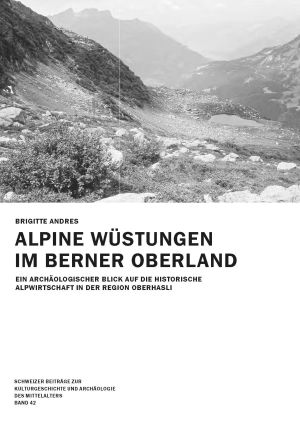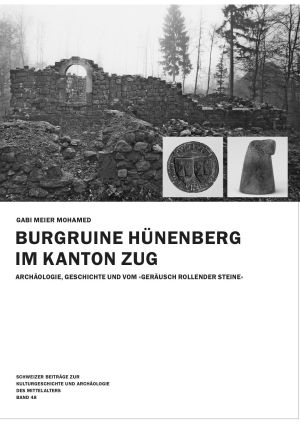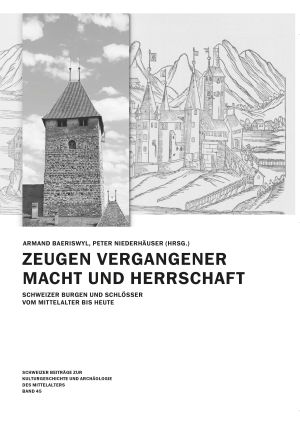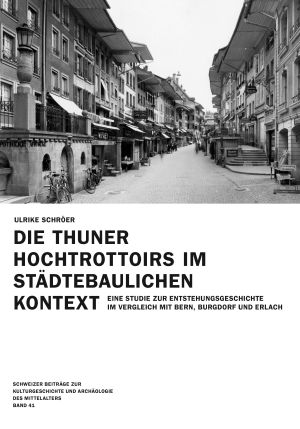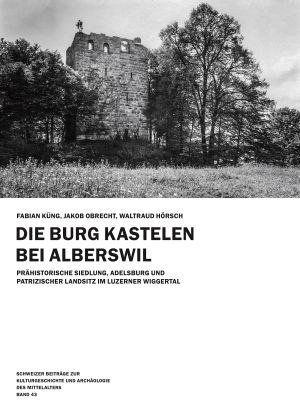Gutscher, Daniel
Alpine Wüstungen im Berner Oberland: Ein archäologischer Blick auf die historische Alpwirtschaft in der Region Oberhasli
The Alpine pastures in the Oberhasli region in the eastern Bernese Oberland have been used for centuries to summer livestock and to make cheese. The remains of dry-stone walls from derelict buildings that were left to decay are often still visible in the landscape. Some 400 newly discovered features, which were recorded during large-scale surveys in the region attest to a variety of constructions used in the Alpine economy. This publication discusses these and assesses them in the context of the regional history of Alpine economic activity. Drawing on archaeological, historical and ethnographic sources, another question explored is how remains of typical Alpine economic activities such as dairying, livestock grazing and haymaking can be detected in the archaeological record. An extensive catalogue of texts and images allows readers to compare deserted Alpine buildings and settlements beyond the Bernese Oberland.
Burgruine Hünenberg im Kanton Zug: Archäologie, Geschichte und vom «Geräusch rollender Steine»
A listed monument since 1962, the ruined castle at Hünenberg is one of the most important monuments of medieval cultural history in Canton Zug. The castle was built as early as 1100. Elaborately worked building blocks, colourfully painted exterior render and precious objects suggest that those who built it were members of the high nobility. The castle was later acquired by the Lords of Hünenberg, who over the course of the 13th and 14th centuries advanced their position to become one of the leading families of the minor nobility in the region. The most recent archaeological excavations, mounted over several short periods between 2005 and 2010, were the first to take advantage of modern scientific methods to examine a medieval castle site. The results of the analyses yielded surprising new insight into the castle’s history of construction and the lives of its former inhabitants.
Zeugen vergangener Macht und Herrschaft: Schweizer Burgen und Schlösser vom Mittelalter bis heute
The 2016 conference in Spiez gave an insight into the current state of castle research and highlighted aspects of social and cultural history as well as the history of power. The proceedings begin with an introduction to the topic of medieval aristocracy and castle construction (Thomas Biller). This is followed by studies of the castles of the Zähringen dynasty (Heinz Krieg) and in the former diocese of Geneva (Matthieu de la Corbière), a case study of Colombier Castle in Canton Neuchâtel (Ferdinand Pajor) and an overview of early castle construction in what is today Swiss territory (Armand Baeriswyl). Special attention is then devoted to the Habsburg fortified border after 1499 (Peter Niederhäuser). A chronological trajectory from the Middle Ages to the present is drawn by papers on castle construction (Jürg Schweizer) and the castle revival (Elisabeth Crettaz) as well as a study of how castles are used today (Thomas Pauli-Gabi). The publication also contained short monographs and illustrations of 25 Swiss castles that are important from the point of view of both research history and castle typology.
Die Thuner Hochtrottoirs im städtebaulichen Kontext: Eine Studie zur Entstehungsgeschichte im Vergleich mit Bern, Burgdorf und Erlach
The specific character of the Obere Hauptgasse in Thun is shaped by its unusual cross section. Ground floors known as raised pavements, arcades or terraces jutting out on both sides form a row of two-storey shops. Whether this was planned, or whether it resulted from the construction type or just by coincidence, the background of this streetscape that stands out from the otherwise anonymous urban development has never before been investigated in detail, despite its quaintness and originality. The question is whether the phenomenon of the double access was a very early example of this type of architecture, a consequence of a later development or even a product of urban planning.
Due to the fragmentary nature of the architectural contexts and an incomplete evidentiary background, it has not yet been possible to firmly establish the origins of Thun’s raised pavements. While the investigation uncovered evidence to suggest that the street gradient had been altered, it was not possible to provide irrefutable proof of this. Even the date proposed for the initial construction of the raised pavements in the 16th/17th centuries seems rather vague. What is certain, however, is that today’s homogenous appearance is in fact based on complex causes and decisions.
Die Die Burg Kastelen bei Alberswil: Prähistorische Siedlung, Adelsburg und patrizischer Landsitz im Luzerner Wiggertal
Die archäologischen Spuren auf dem Burghügel von Kastelen reichen weit in die Prähistorie zurück: Bereits in der Bronzezeit vor 3000 Jahren bestand auf dem Kastelenhügel eine dörfliche Siedlung. Im Hochmittelalter wurde der markante Hügel zum Standort einer hölzernen Burganlage. An ihrer Stelle liessen die Grafen von Kyburg zwischen 1249 und 1253 eine ausgedehnte Burg errichten, von welcher heute noch die Ruine des Wohnturms sowie der Sodbrunnen erhalten sind. Der beeindruckende Wohnturm ist ein beredter Zeuge der hochstehenden mittelalterlichen Bautechnik. Zusammen mit den archäologischen Funden lässt die Ruine einen unmittelbaren Einblick in die Wohnkultur und das Leben auf einer mittelalterlichen Adelsburg zu.
Die historischen Schriftquellen zur Burg Kastelen erzählen von der geschichtlichen Entwicklung der gesamten Region: Sie zeigen nicht nur den gesellschaftlichen Wandel in der herrschenden Oberschicht während des Mittelalters und der Neuzeit, sondern werfen auch ein Schlaglicht auf die sozialen Verhältnisse beispielsweise zur Zeit des Bauernkriegs von 1653.
Weitere Kapitel sind den bautechnischen und denkmalpflegerischen Aspekten einer Burgenrestaurierung gewidmet. Abgerundet wird die Publikation durch eine Untersuchung zu den Sagenerzählungen rund um die Ruine Kastelen.



